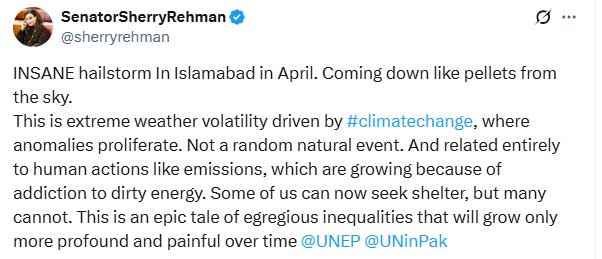Hailstorm wreaks havoc on cars, trees, traffic in Islamabad, KP
NDMA issues warning of extreme summer, heatwaves, and wildfire risks in KP, Balochistan, Potohar, Murree
April 16, 2025
The federal capital and parts of Khyber Pakhtunkhwa (KP) were pummelled by a heavy hailstorm on Wednesday afternoon, leaving a trail of destruction that included smashed car windscreens, damaged solar panels, and broken tree branches.
In Islamabad, the storm hit suddenly and lasted around 35 minutes, with strong winds and large hailstones battering everything in their path. Tarnol was among the worst-affected areas, where several trees were uprooted, causing traffic disruptions.
The downpour also triggered flash flooding in some low-lying parts of the capital, straining the already overwhelmed drainage systems and catching commuters off guard.
Several politicians took to X to share their stormy experiences, describing the wild weather as both intense and oddly refreshing — a dramatic spell that brought a welcome break from the heat.



Power grid bears the brunt
Heavy rain and hail disrupted Islamabad Electric Supply Company's (IESCO) power distribution system, with several areas experiencing outages due to fallen electricity poles and broken wires, per a power utility spokesperson.
Power supply was suspended across many 11kv feeders due to safety faults and tripping. Affected areas included Golra, PHA, Pir Mehr Ali Shah, F-10 Markaz, National Police Foundation, Service Road East, Carriage Factory, Patriata, Upper Topa, Pir Sohawa, Madina Colony, and Airport Society.
Feeders in New Race Course, Abu Bakar Shakrial, Khayaban-e-Sir Syed, Faizabad, and Committee Chowk were also impacted. Others included Japan Road, Chontra, 502 Workshop, Sukho, Sangjani, Shah Allah Ditta, Machine Mohallah, Gujar Khan, Domeli, and COD Kala.
The spokesperson said IESCO’s operations and construction teams restored power in most areas before long.
"IESCO Chief Engineer Muhammad Naeem Jan is directly supervising the restoration work," the spokesperson added.
Extreme weather alert
Meanwhile, the National Disaster Management Authority (NDMA) has forecast extreme summer conditions, warning of intensifying heatwaves that could heighten the risk of wildfires in mountainous regions of Khyber Pakhtunkhwa, Balochistan, the Potohar region, Murree, and nearby areas.
The three-month forecast (April–June), presented to reporters at the NEOC, indicates that cyclones are expected to form in the Arabian Sea during May and June, with potential impacts on nearby coastal areas.
The report indicates that the summer season will bring higher-than-normal temperatures nationwide and below-average rainfall. This extreme heat is anticipated to cause heat waves, especially in southern Punjab, Sindh, and Balochistan.
Temperatures in southern Punjab, Sindh, and Balochistan could climb as high as 45 degrees Celsius, particularly impacting cities such as Karachi, Badin, Larkana, Umerkot, Tharparkar, and Matiari.
Searing temperatures are expected to scorch Sukkur, Shikarpur, Dadu, Sanghar, Bahawalpur, Rahim Yar Khan, and Lahore, whereas Gilgit-Baltistan and Chitral face a dual challenge—extreme heat coupled with the looming threat of GLOFs triggered by rapid glacial melting.
The combination of higher temperatures and diminished rainfall is projected to reduce agricultural output nationwide, potentially causing lower crop yields, water scarcity, and food security challenges.
The NDMA urged the public to avoid exposure to extreme heat, particularly during peak sun hours, and take necessary precautions to prevent heat-related illnesses. Adhering to these safety measures can help minimise health risks during high temperatures.











